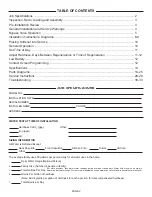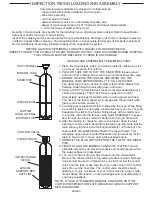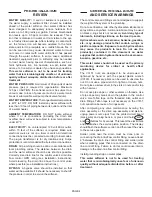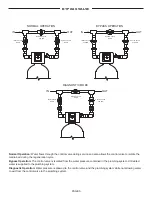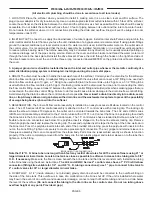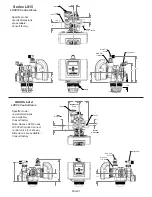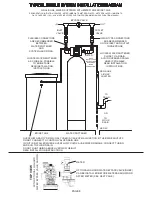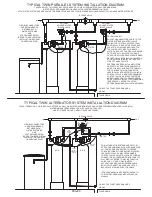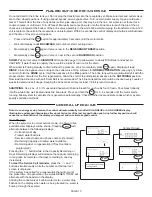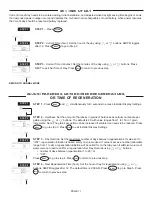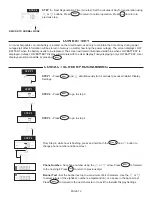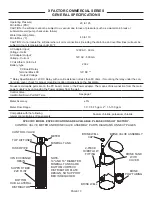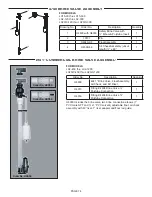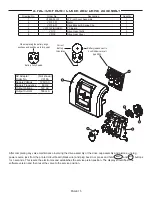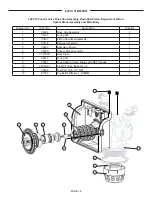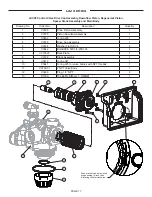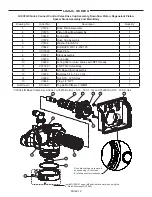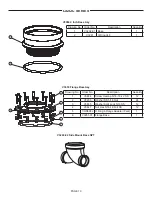
PAGE 4
The control valve and fittings are not designed to support
the weight of the system or the plumbing.
Do not use Vaseline, oils, other hydrocarbon lubricants or
spray silicone anywhere. A silicone lubricant may be used
on black o-rings but is not necessary.
Avoid any type of
lubricants, including silicone, on the clear lip seals.
Hydrocarbons such as kerosene, benzene, gasoline,
etc., may damage products that contain o-rings or
plastic components. Exposure to such hydrocarbons
may cause the products to leak. Do not use the
product(s) contained in this document on water
supplies that contain hydrocarbons such as kerosene,
benzene, gasoline, etc.
This water meter should not be used as the primary
monitoring device for critical or health effect
applications.
The V3151 nuts are designed to be unscrewed or
tightened by hand or with the special plastic wrench
(V3193). If necessary, pliers can be used to unscrew the
nut. Do not use a pipe wrench to tighten or loosen nuts.
Do not place a screw driver in the slots on nuts and/or tap
with a hammer.
Do not use pipe dope or other sealants on threads. Use
of pipe dope may break down the plastics in the control
valve. Use Teflon tape on the threaded inlet, outlet and
drain fittings. Teflon tape is not necessary on the V3151
nut connection because of o-rings seals.
After completing any valve maintenance involving the
drive assembly or the drive cap assembly and pistons,
unplug power source jack from the printed circuit board
(black wire) and plug back in or press and hold
NEXT
and
REGEN
buttons for 3 seconds. This resets the electronics
and establishes the service piston position. The display
should flash the software version and then reset the valve
to the service position.
Solder joints near the drain must be done prior to
connecting the drain line flow control fitting. Leave at least
6” between the drain line control fitting and solder joints
when soldering pipes that are connected on the drain
line control fitting. Failure to do this could cause interior
damage to the drain line flow control fitting.
Install grounding strap on metal pipes.
This water softener is not to be used for treating
water that is microbiologically unsafe or of unknown
quality without adequate disinfection before or after
treatment.
GENERAL INSTALLATION
AND SERVICE WARNINGS
PRE-INSTALLATION
REVIEW
WATER QUALITY:
If sand or sediment is present in
the water supply, a sediment filter should be installed
ahead of the water softener. Your water softener has
been designed to adequately reduce hardness from
levels up to 100 grains per gallon. Ferrous bicarbonate
iron levels up to 0.5 ppm can also be reduced. This is
iron that is dissolved in water and not visible to the eye
in a freshly drawn sample. After standing in contact with
air, the ferrous iron will become oxidized to the ferric
state and start to precipitate as a reddish brown floc. It
can be seen and may cause discolored water. Air must
not come in contact with water until after it has passed
through the water softener. In some cases, additional
treatment equipment prior to softening may be needed
to treat water having special characteristics, such as:
ferric hydroxide iron, iron bacteria, low pH, tastes and
odors, etc. Consult your dealer if you have any questions.
This water softener is not to be used for treating
water that is microbiologically unsafe or of unknown
quality without adequate disinfection before or after
treatment.
WATER PRESSURE:
A minimum of 20 pounds of water
pressure (psi) is required for regeneration. Maximum
125 psi. CAUTION: the softener cannot be subject to a
vacuum due to loss of pressure (such as a water main
break or submersible well pump check valve failure).
WATER TEMPERATURE:
The range of water temperature
is 40°F to 110°F. DO NOT install any water softener with
less than 10 feet of piping between its outlet and the inlet
of a water heater.
AMBIENT TEMPERATURE:
DO NOT locate softener
where it or its connections (including the drain and
overflow lines) will ever be subject to room temperatures
under 40°F.
ELECTRICITY:
An uninterrupted 120 volt 60Hz outlet,
within 15 feet of the softener, is required.
Make sure
electrical source is not on a timer or switch.
All electrical
connections must be connected according to local codes.
The plug-in transformer is for dry locations only. Surge
protection is recommended with all electrical connections.
DRAIN:
All plumbing should be done in accordance with
local plumbing codes. The distance between the drain
and the water softener should be as short as possible.
Correctly size drain line for the control valve’s drain line
flow control GPM rating (see installation instructions).
Avoid elevating the drain line above the control valve
where possible (see installation instructions).
BYPASS:
A bypass valve should be installed so that
water will be available if it should be necessary to shut off
the pressure in order to service the softener.
NORMAL OPERATION
BYPASS OPERATION
DIAGNOSTIC MODE
IN
OUT
IN
OUT
IN
OUT
INLET VALVE
OPEN
OUTLET VALVE
OPEN
BYPASS VALVE
CLOSED
INLET VALVE
CLOSED
OUTLET VALVE
CLOSED
BYPASS VALVE
OPEN
INLET VALVE
OPEN
OUTLET VALVE
CLOSED
BYPASS VALVE
OPEN
Click to buy NOW!
PD
F-XCHANGE
w
ww
.docu-track.c
om
Click to buy NOW!
PD
F-XCHANGE
w
ww
.docu-track.c
om
Содержание LX15 Series
Страница 34: ...PAGE 34 NOTES ...
Страница 35: ...PAGE 35 ...


